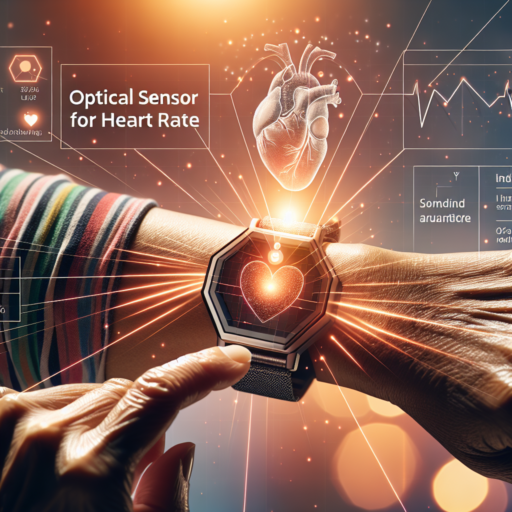How does an optical sensor measure heart rate?
Optical sensors, utilized in a variety of wearable devices, operate on a simple yet fascinating principle to measure heart rate. These devices, commonly found in smartwatches and fitness bands, employ a technology known as photoplethysmography (PPG) to detect blood volume changes in the microvascular bed of tissue. At the core of this technique is the use of LED lights, which emit light that penetrates the skin and is then reflected by the blood. The amount of light that returns to the sensor varies with the blood flow, which in turn is influenced by the heartbeat.
When your heart beats, the blood flow in your wrist—and the absorption of light by the skin—increases, causing less light to return to the optical sensors. Conversely, between beats, blood flow decreases, resulting in more light bouncing back. The optical sensor collects these variations in light intensity and, with the help of advanced algorithms, converts them into electrical signals that can be calculated to determine the heart rate. This process happens continually, allowing devices to provide real-time monitoring of the wearer’s heart rate.
Moreover, the accuracy of these optical heart rate sensors has greatly improved over the years, thanks to advancements in sensor technology and data analysis techniques. Manufacturers often combine multiple LED diodes, emitting different wavelengths of light (such as green, red, and infrared), to enhance the sensor’s ability to accurately detect heart rate under various conditions, including different skin tones, levels of physical activity, and environmental factors. This adaptability makes optical heart rate measurement a convenient and non-invasive method for individuals looking to monitor their health and fitness levels.
What sensors are used to detect heart rate?
The measurement of heart rate is pivotal in assessing the cardiovascular health of an individual. Technological advancements have led to the development of various sensors aimed at making heart rate detection more accurate and accessible. Below, we delve into the most commonly used sensors for this purpose.
Photoplethysmography (PPG) Sensors
At the forefront of heart rate detection technology are Photoplethysmography (PPG) sensors. PPG sensors operate by emitting light into the skin and measuring the amount of light either absorbed or reflected by the blood vessels. This method capitalizes on the fact that blood absorbs light more when it’s oxygen-rich, providing a clear indication of heartbeats. Primarily used in wearable technology like smartwatches and fitness bands, PPG sensors offer the convenience of tracking heart rate continuously without needing specialized equipment.
Electrocardiogram (ECG) Sensors
For those requiring a more detailed analysis of heart health, Electrocardiogram (ECG) sensors present a more sophisticated approach. By detecting the electrical activity of the heart through electrodes placed on the skin, ECG sensors can provide insights into the heart’s rhythm and identify any irregularities. Despite being more commonly found in medical settings, recent advancements have integrated miniature ECG sensors into consumer devices, making them a part of everyday health monitoring.
Understanding the mechanics behind heart rate detection sensors is crucial for choosing the right technology that fits one’s lifestyle and health requirements. Whether it’s the convenience and continuous monitoring offered by PPG sensors or the detailed heart rhythm analysis provided by ECG sensors, the goal remains the same: to offer a reliable measure of heart health that can guide personal and medical decisions.
No se han encontrado productos.
What is the most accurate heart rate sensor?
When it comes to monitoring heart rate, accuracy is paramount for athletes, fitness enthusiasts, and individuals monitoring health conditions alike. The most accurate heart rate sensors tend to be chest strap monitors. These devices use electrical signals to precisely detect heart rate, making them significantly more reliable than their wrist-worn counterparts, which rely on optical technology.
While wrist-based devices, such as fitness watches and smartwatches, are more convenient and comfortable for everyday wear, they can sometimes struggle with accuracy, particularly during intense physical activity or if the device is not positioned correctly. Chest strap monitors, on the other hand, maintain direct contact with the skin near the heart, ensuring continuous, high-fidelity heart rate data.
However, it’s worth noting that the technology behind wrist-worn heart rate sensors has seen considerable improvements over the years. Leading manufacturers have been continually refining their optical sensors to enhance accuracy. These advancements mean that for many users, the convenience of a wrist-worn device might outweigh the slight increase in accuracy offered by a chest strap.
What is the difference between the optical heart sensor and the electrical heart sensor on the Apple Watch?
The Apple Watch series has revolutionized the way we monitor our health, incorporating sophisticated technology to offer a comprehensive overview of our well-being. A key feature in this transformative device is its ability to track heart rate through two distinct types of sensors: the optical heart sensor and the electrical heart sensor. Each sensor utilizes a different technology and provides unique insights into the functionality of the heart.
The optical heart sensor, first introduced with the original Apple Watch, operates using what is known as photoplethysmography. This technology involves green LED lights flashing hundreds of times per second and photodiodes, which measure the amount of blood flowing through your wrist at any given time. The variations in blood flow are then analyzed to calculate your heart rate. The optical sensor is particularly adept at measuring your heart rate during periods of rest or low levels of activity.
In contrast, the electrical heart sensor was introduced in later models of the Apple Watch, providing a more detailed view of heart health. This sensor includes an electrical heart rate sensor that can capture heart rhythm (or your heart’s electrical patterns) in addition to the heart rate. Users can take an Electrocardiogram (ECG) by placing their finger on the Digital Crown of the watch, which completes a circuit with sensors located on the back of the watch. This technology can indicate signs of atrial fibrillation, a serious form of irregular heartbeat.




